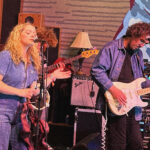Early Voting: Its definition and its significance in 2012
By KRUI News reporter Michael Gerald
Early voting has represented many things this election cycle. It has been a political talking point, a political strategy, a motivational tool, and for many Iowans it has been represented by satellite early voting sites and door to door canvassing. Although early voting is available to voters of any party affiliation, according to Professor Timothy Hagle of the University of Iowa, historically Democratic voters are much more likely to vote early whereas Republican voters have higher turnout rates on Election Day. Although it is difficult to track the results of early voting, Professor Michael McDonald of George Mason University and the United States Elections Project has reported that currently in all reporting jurisdictions there have been over 29 million ballots already cast. Of those 29 million, the statistical breakdowns among the states show that the historical trends of high Democratic voter returns on early voting are mostly holding true. In Iowa, for instance, as of November 4th over 613,000 Iowans have already cast ballots and 42% have been cast by registered Democrats compared to 32% by Republicans. Similarly in Nevada, another swing state, over 701,000 early votes have been cast with 43% coming from Democrats compared to 37% from Republicans.
The news is not all bad for Republicans, however. In Colorado and Florida registered Republicans have an early voting edge of 3% and 5% respectively. What is the reason for the disparities? What is the significance of early voting, if any?
According to Professor Hagle one of the primary differences between the Democratic and Republican constituencies is age. Younger voters, specifically college age voters between 18 and 24, tend to vote more with Democrats, but have lower voter turnout than older voters who are likely to vote Republican. So early voting represents an opportunity, maybe even a strategy, to get younger voters to the polls. Professor Hagle noted that there are two typical types of early voting: voting by absentee ballot, and early in-person voting at satellite polling places. Historically early voting has been an avenue for people to vote who could not otherwise vote on Election Day at their respective polling place. These could be individuals who had moved away for school, those who may be out of town or working on Election Day, or even those who are ill and in the hospital.
Professor Paul Gronke of the Early Voting Information Center based at Reed College cites a Constitutional basis for early voting as a result of a 1999 ruling in Texas. The overall decision was that early voting does not decide the election prior to the first Tuesday in November (which is the Federal statute) and therefore does not conflict with Constitutional regulations. The recent expansion of early voting, and even the resistance to it, is a complex and multifaceted issue.
This still does not fully address the question of the significance of early voting in 2012 and why it has been a dominant topic in the conversations surrounding the presidential election. It appears to have become an electoral force for Democrats and a point of contention for Republicans. Katherine Valde, President of the University Democrats at the University of Iowa, spoke explicitly about the demographic differences between the parties. Katherine pointed out that not only are young college students voting as Democrats more often, but Democrats are also represented persons who are of low Socioeconomic Status (SES), and other communities whose votes may be difficult to ascertain. According to Kathryn, “Early voting gives us an opportunity to track these voters down.” Early voting from the Democratic point of view, represents not only more votes and potentially more electoral victories but also an opportunity to extend the opportunity to vote to those who may not otherwise be able to according to Professor Hagle. This is reflected in the early voting activities seen around Iowa City. While many took place on the University of Iowa campus, there were also early voting satellite sites at the Downtown Library, HyVee grocery stores, and the County Auditor’s office, just to name a few.
Early voting has not been without its detractors, however, as many states, particularly those with Republican Governors or Republican dominated legislatures, have sought to limit the amount of early voting and voter registration that can take place. Attempts to reduce early voting in Ohio and attempted voting requirements of a state-issued photo ID in Pennsylvania were both causes championed by conservatives in those states. When asked about this point of contention, Professor Hagle discussed the two different viewpoints surrounding the issue. Whereas Democrats may view early voting as a manner of expanding the electorate and giving voice to those who may be disenfranchised, Republicans view the early voting process as potentially harming the integrity of the elections by leaving the door open to voter fraud. “Republicans see concerns in terms of voter fraud, for example, people having been bused to more than one location or people using fake ID’s,” said Professor Hagle. These tend to be the concerns that Republicans focus on. Both of these statements represent the ideological viewpoint and are not indicative of a political strategy, which is what both parties have accused the other of.
It seems, then, that the significance of early voting depends on party affiliation and political strategy. Early voting in 2012 is expected to exceed the 41 million early votes cast in the 2008 election and going forward it will represent a larger issue within political campaigns. Whether early voting is seen as a political tactic or democracy-enriching initiative, it is growing in size and popularity among voters. Early voting’s impact on an election is hard to measure, Professor Hagle said. But there is little doubt that early voting is somewhat impactful as according to CNN both President Obama and Vice Presidential candidate Paul Ryan encouraged supporters at rallies to get out and vote early. Early voting is not Democratic or Republican. It is a significant part of the election process now and its significance should be measured. Interest in early voting colliding with efforts to restrict early voting (referred to as “voter suppression” by Democrats) has resulted in long lines and hours-long wait times in states such as Ohio and Florida; key battleground states in this election. The drive for undecided voters, or independents, is part of this heavy emphasis on the early voting process. Professor Hagle noted, “In 2008, 80% of registered voters among Republicans and Democrats turned out, whereas only 61% of registered voters not affiliated with a political party, referred to in Iowa as Independents, turned out.” Katherine Valde concluded, “Early voting is something that is extremely valuable and will become a large part of field organizing in the future.” Whatever one’s political affiliation, early voting is a significant part of the electoral process that deserves attention as we do not yet know its full impact or implications for the future.




